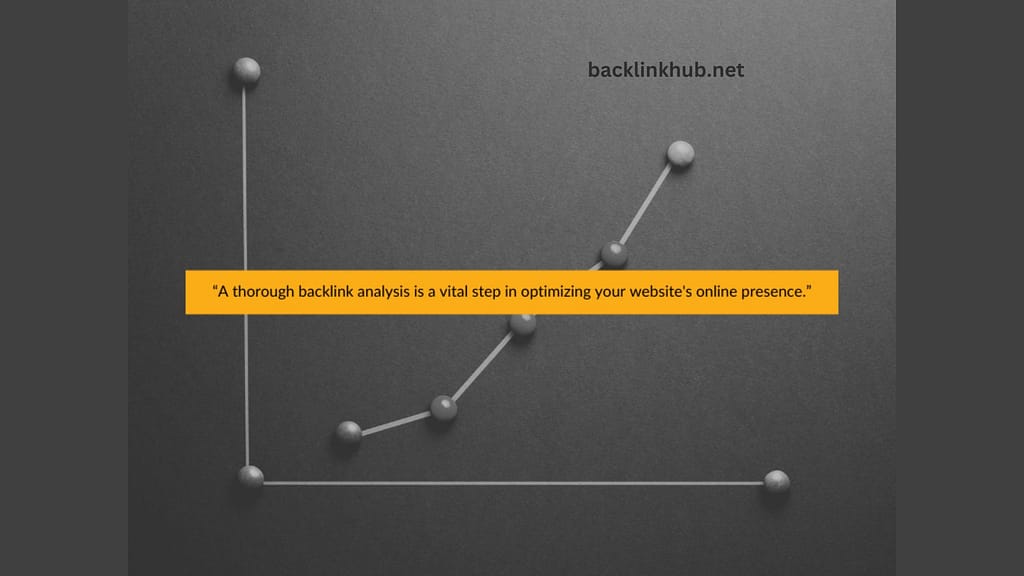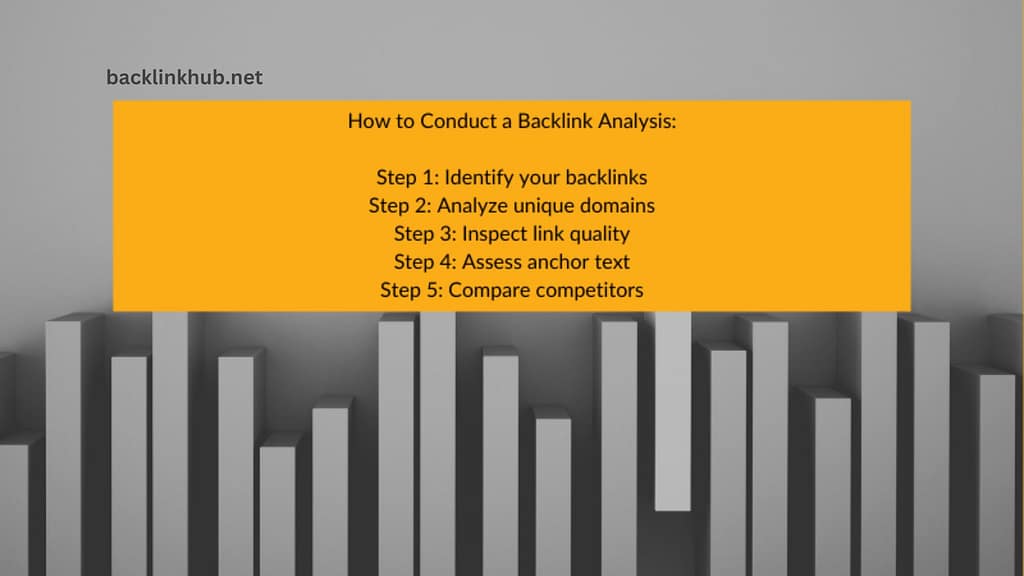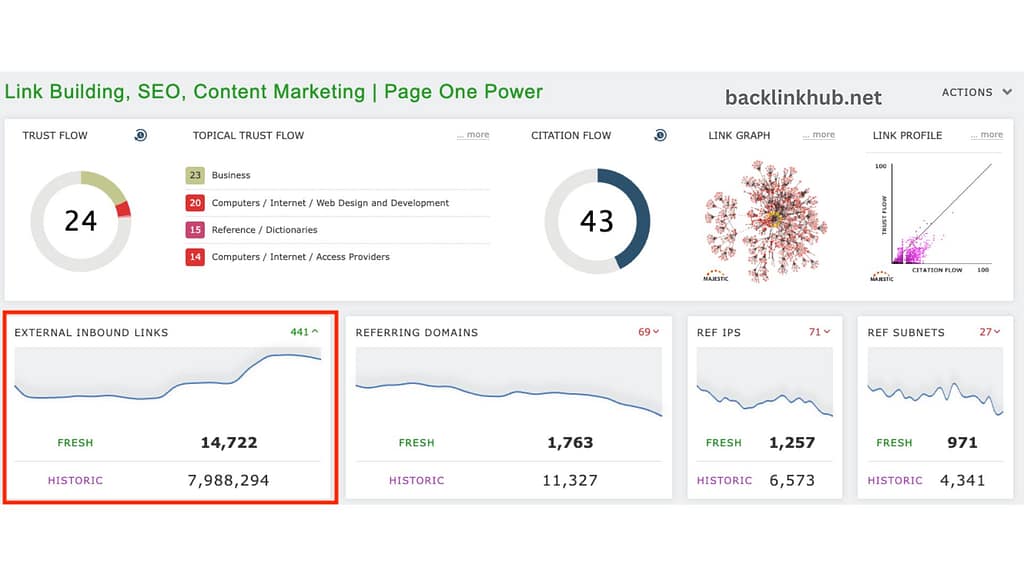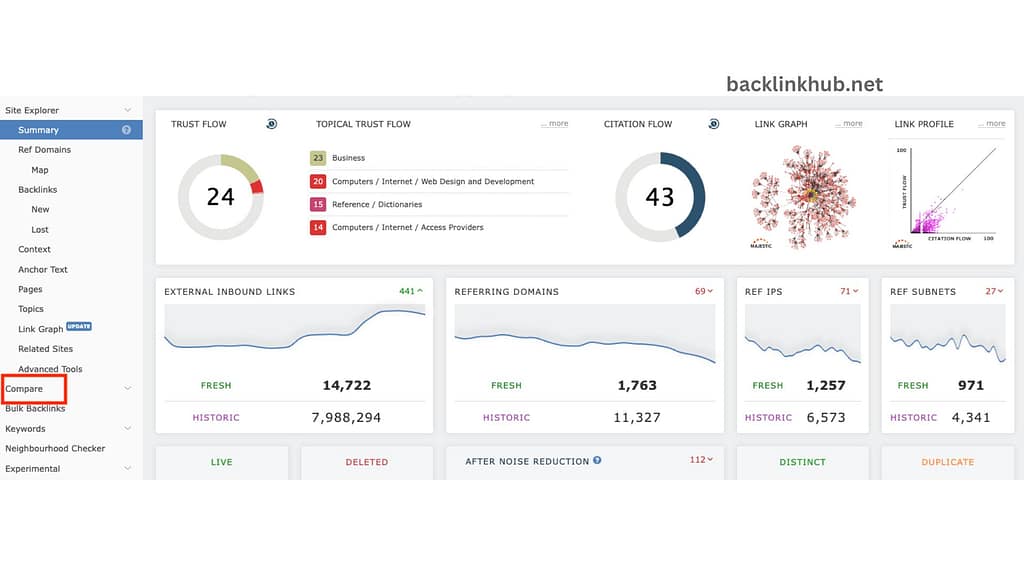Link building is essential for improving your search rankings and staying competitive. Google has always emphasized that a strong link profile plays a big role in how they rank sites. So, if you want to keep up in the game, having a solid link-building strategy is a must.
But how do you decide which backlinks to focus on? Start by checking your current link profile. This is where a backlink analysis comes in handy. By looking at your existing backlinks, you can figure out what you’re missing and see where your competitors are getting their links.
In our link-building agency, we always begin by examining the backlink profiles of our clients. This helps us understand their strengths, weaknesses, and opportunities before we develop a tailored link-building strategy.
In this post, we’ll dive into why backlink analyses are important, how to conduct one, and what steps to take next.
What Is a Backlink Analysis?

When you do a backlink analysis, it’s crucial to thoroughly check out your website’s backlink profile. This deep dive gives you valuable insights into how effective your backlinks are, their relevance, and their overall quality.
By evaluating your backlinks, you can figure out how they impact your search engine rankings and develop strong link-building strategies. This helps you pinpoint areas where you can improve your website’s online visibility and SEO efforts.
A thorough backlink analysis is key to boosting your site’s presence and staying ahead of competitors in the ever-changing digital world.
Why is a Backlink Analysis Important for Link Building?

Getting the right links is key to successful link building. It’s more about having quality links from reputable sites that show you’re an authority on your topic than just having a lot of links. Good inbound links can drive more traffic by reaching people who might not have found your site otherwise.
Before you start link-building, it’s important to check out your current backlink profile. A backlink analysis helps you see what’s working, what isn’t, and where you can improve.
You should also look at your competitors’ backlink profiles. This can give you insights into their link sources and help you create even better content to outshine them.
Checking how many sites link to your content can show how valuable readers find it. The more sites that link to your content, the more valuable it’s seen as. This can guide your content strategy.
Finally, a backlink analysis helps you assess the quality of your links and fix any broken or spammy ones.
When to Perform a Backlink Analysis

To really understand how your website is performing online, a backlink study is crucial. Just like with other SEO tasks, you should check your backlinks regularly to ensure everything’s working well. However, there are certain situations where a backlink study becomes especially important, such as:
- A drop in your rankings
- A decrease in traffic
- Content that’s not performing as expected
- Updates to search engine algorithms
- Before launching a new link-building campaign
- After receiving a manual penalty
Regularly analyzing your backlinks helps you see both the quantity and quality of your links and shows you how to improve your SEO results.
Tools You Need for a Backlink Analysis

Going through thousands of backlinks by hand can be overwhelming. Luckily, there are plenty of tools that can handle this tough job for you. Some popular ones are:
- Ahrefs
- Semrush
- Moz
- Serpstat
- Majestic SEO
- Cognitive SEO
Each of these tools offers link analysis features. It’s a good idea to explore each one to see which fits your needs best. You might even want to use a few different tools to get the most comprehensive information.
Also Read: Backlink Gap Analysis for Link Opportunities
How to Conduct a Backlink Analysis

Once you’ve picked your tool, the next step is to dive into your backlink analysis. There are different ways to analyze your backlinks based on what you want to achieve, but every report should include these key details:
- Referring domains
- Total number of links from each domain
- Quality metrics
- Anchor text
- Linking page
- Index and URL status
Understanding these basics is crucial for getting a clear picture of your backlink profile. By carefully examining this data, you’ll get the most insights into your profile. In the next sections, we’ll use Majestic SEO as an example to walk you through the process.
Step One: Identify Your Backlinks
To check the total number of backlinks to your website, just plug your domain name into an SEO tool like Majestic SEO. This will show you how many backlinks are pointing to your site, which is a key indicator of your site’s authority.
Here’s a screenshot from Majestic SEO:

However, just knowing the total number of backlinks isn’t enough on its own. To get a clearer picture of how your site is doing, compare your total backlinks and referring domains with those of your competitors.
You can also dig deeper by looking at which pages on your site are the most valuable. For instance, you might want to see how well your blog posts are performing. By breaking down your target pages and analyzing their performance, you’ll get a more detailed view of your site’s strengths and weaknesses. Remember, counting backlinks is just the first step in evaluating your website’s performance.
Step Two: Analyze Unique Domains
You can carefully examine each backlink to determine its source, or your SEO tool will tell you how many distinct websites are linking to your website.
You can determine how many of your backlinks come from different websites by breaking out your backlink profile by unique domain.
Here’s how to use Majestic SEO to segment based on unique domains:

And this is how that screen appears:

As previously said, having a large number of backlinks—especially from spammy sites—does not help a website rank well in search engines. Rather, websites with high-quality backlinks are rewarded by search engines. Furthermore, a single website with thousands of backlinks may appear artificial to search engines, raising a warning sign.
Instead, to demonstrate to search engines that your website is equally authoritative, make sure you have backlinks from a variety of reliable, pertinent pages. Therefore, you may improve your link building approach and find new link chances by finding out which websites are already linked to yours.
Step Three: Inspect Link Quality
Next, focus on the quality of your links. Search engines prefer links that are relevant and from trustworthy sources. Third-party tools measure several factors to rate these links, including:
- Relevance
- Domain authority
- Page authority
- Citation flow
- Trust flow
- Domain rating
These metrics are useful for assessing link quality, but don’t take them as the final word. They’re good indicators, but relevance and real value are what really matter.
Relevance helps search engines filter out spammy links and ensure that the backlinks you get are from sites that match your content. This helps your website perform better in search results.
Adding human value to your link-building efforts ensures that the links not only come from legitimate sites but also genuinely enhance the user experience on your website. This way, you’ll get valuable backlinks rather than just links that look good on paper.
What Are Toxic Links?
A poisonous backlink is one that can hurt your website’s SEO and rankings. These links are often considered manipulative or spammy. Google defines them as links intended to mess with PageRank or a website’s search results position, which can go against Google’s Webmaster Guidelines. This includes any tactics that manipulate links to or from your site.
Examples of these harmful links include:
- Links from link networks
- Links in website footers
- Links from web directories
- Links in blog comments
- Links from article directories
- Exact-match anchor text
- Paid links
- Excessive link exchanges
- Links from automated tools
- Sponsored links
Step Four: Assess Anchor Text
Site links pointing to yours are displayed to you via anchor text. It gives search engines one more indication of significance. The anchor text for each backlink should be displayed by your SEO tool.
Use the left-side menu in Majestic SEO to find the anchor text:

And this is how that screen appears:

When looking at anchor text, keep these tips in mind:
- Use partial match anchor text: This is great for adding context and focusing on long-tail keywords.
- Set expectations: Good anchor text should give readers an idea of what the content is about without needing them to click through.
- Diversify your anchor text: Use different keywords to target similar pages.
- Change what you can, accept what you can’t: You can ask others to change the anchor text they use to link to your site, but sometimes you’ll have to go with what you’ve got.
By paying attention to these details, you can make sure that your backlinks are optimized to bring the most traffic to your site.
Step Five: Compare Competitors
It’s critical to assess your website’s performance in comparison to your rivals now that you have a comprehensive understanding of it. A backlink gap study may be performed with tools such as Ahrefs and Semrush, which will display the domains that link to your rivals.
By selecting “compare” from the left-side menu in Majestic SEO, you can compare the backlink profiles of competitors. After that, you may select any elements—such as a summary, backlink history, flow metric history, and topics—you want to compare.

This is the screen that should appear, allowing you to compare up to ten distinct root domains:

In the event that a gap analysis is not a possibility for you, you can still use your SEO tool to enter the URL of your rival and examine their backlink profile. Apply the same methodology to your own website. You can learn important things about your competitors by looking at their backlink profile, including:
- Identifying top-performing content
- Discovering websites that link to your competitors but not to you.
After the Backlink Analysis

So, what’s next after you’ve finished your backlink analysis? It might feel overwhelming with all the data, but don’t worry. Here are some steps you can take now that you understand your backlink profile:
- Keep an eye on your backlinks regularly: This helps you stay updated on how your links are performing.
- Do more targeted outreach: Reach out to websites with a clear and focused strategy based on your analysis.
- Create content that works: Use the insights from your analysis to produce content that performs well and attracts more links.
- Consider outsourcing: If needed, get help with link building to reach your targeted audience more effectively.
- Watch out for link spam: Check for any spammy links and address them.
- Submit a Disavow file: If you find harmful links, use a Disavow file to tell search engines to ignore them.
A successful link-building strategy relies on regular backlink analysis. By identifying areas for improvement and taking action based on your findings, you can boost your website’s online presence. Regular checks will keep you ahead in the ever-changing digital world. So, if you haven’t started yet, now’s a great time to dive into your backlink profile and enhance your link-building efforts.




Pingback: Complete Guide to Link Diversity for SEO